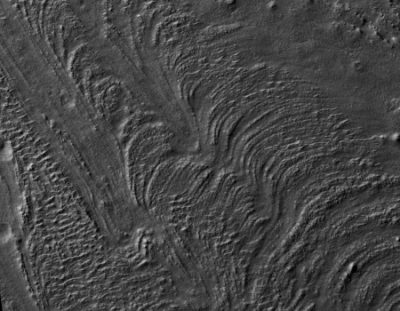A glacier on Mars

Cool image time! The image on the right, cropped and reduced in resolution, is a Mars Reconnaissance Orbiter picture taken on March 28, 2016 of a glacial flow coming down off of mountains in Mars’ northern mid-latitudes. The mountains are to the south and beyond the bottom right. The flow is to the northwest. The full image can be found here. As noted on the image site,
These flow-like structures were previously called “lobate debris aprons,” but the Shallow Radar (SHARAD) instrument on [Mars Reconnaissance Orbiter] has shown that they are actually debris-covered flows of ice, or glaciers. There is no evidence for present-day flow of these glaciers, so they appear to be remnants of past climates.
Need I say it? This is water, on Mars, and in abundance. Think that this might be good real estate when those first settlers arrive?
On Christmas Eve 1968 three Americans became the first humans to visit another world. What they did to celebrate was unexpected and profound, and will be remembered throughout all human history. Genesis: the Story of Apollo 8, Robert Zimmerman's classic history of humanity's first journey to another world, tells that story, and it is now available as both an ebook and an audiobook, both with a foreword by Valerie Anders and a new introduction by Robert Zimmerman.
The print edition can be purchased at Amazon or from any other book seller. If you want an autographed copy the price is $60 for the hardback and $45 for the paperback, plus $8 shipping for each. Go here for purchasing details. The ebook is available everywhere for $5.99 (before discount) at amazon, or direct from my ebook publisher, ebookit. If you buy it from ebookit you don't support the big tech companies and the author gets a bigger cut much sooner.
The audiobook is also available at all these vendors, and is also free with a 30-day trial membership to Audible.
"Not simply about one mission, [Genesis] is also the history of America's quest for the moon... Zimmerman has done a masterful job of tying disparate events together into a solid account of one of America's greatest human triumphs."--San Antonio Express-News

Cool image time! The image on the right, cropped and reduced in resolution, is a Mars Reconnaissance Orbiter picture taken on March 28, 2016 of a glacial flow coming down off of mountains in Mars’ northern mid-latitudes. The mountains are to the south and beyond the bottom right. The flow is to the northwest. The full image can be found here. As noted on the image site,
These flow-like structures were previously called “lobate debris aprons,” but the Shallow Radar (SHARAD) instrument on [Mars Reconnaissance Orbiter] has shown that they are actually debris-covered flows of ice, or glaciers. There is no evidence for present-day flow of these glaciers, so they appear to be remnants of past climates.
Need I say it? This is water, on Mars, and in abundance. Think that this might be good real estate when those first settlers arrive?
On Christmas Eve 1968 three Americans became the first humans to visit another world. What they did to celebrate was unexpected and profound, and will be remembered throughout all human history. Genesis: the Story of Apollo 8, Robert Zimmerman's classic history of humanity's first journey to another world, tells that story, and it is now available as both an ebook and an audiobook, both with a foreword by Valerie Anders and a new introduction by Robert Zimmerman.
The print edition can be purchased at Amazon or from any other book seller. If you want an autographed copy the price is $60 for the hardback and $45 for the paperback, plus $8 shipping for each. Go here for purchasing details. The ebook is available everywhere for $5.99 (before discount) at amazon, or direct from my ebook publisher, ebookit. If you buy it from ebookit you don't support the big tech companies and the author gets a bigger cut much sooner.
The audiobook is also available at all these vendors, and is also free with a 30-day trial membership to Audible.
"Not simply about one mission, [Genesis] is also the history of America's quest for the moon... Zimmerman has done a masterful job of tying disparate events together into a solid account of one of America's greatest human triumphs."--San Antonio Express-News


The rotation axis of Mars has tipped over more and more often than that of Earth, since our big Moon stabilizes us. So there should be ancient polar water ice caps covered by dust here and there. (Maybe glaciers have formed in other ways too). Given heavy mining equipment, many places on Mars are good real estates. But as on Earth, many factors go into picking the best place. Seasons, topography, weather patterns, local resources.
The immediate Mars human space flight objectives should be to visit a laboratory there for about a year every other conjunction at best. First flights to Mars will find out, but not rely on, any resources on Mars as in digging up water ice.